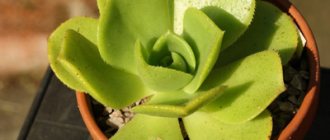Planting material can be purchased from collectors (usually indicating the variety and sometimes the region of growth) or in stores, or you can also get it yourself.
- The seeds are small, dusty.
- Seeds older than 6 months have the best germination rate and retain it for up to 10 years (according to reviews from flower growers).
You can sow succulents all year round, but in autumn and winter, seedlings will need additional lighting (up to 10-12 hours) . For illumination, phytolamps with a special spectrum of rays or simple fluorescent lamps are suitable. The light source is suspended at a distance of 7-10 cm from the plants.
Sowing lithops: what to look for
Priming
- light (1:1:2 - soil, peat, mineral components);
- particle size up to 1 mm;
- sterilized.
Containers
- low and wide, best with a lid;
- filling: drainage, soil, fine sand (1 cm: 1.5-2 cm: 2-3 mm).
Sowing
- organize a “greenhouse”;
- bright lighting, temperature about 25°C;
- shoots - after 3-10 days.
Care
- daily inspection of crops;
- maintaining humidity - the top layer of soil should not dry out;
- picking after the first molt.
By following the rules for planting and subsequent care of succulents, it will not be difficult to grow an entire colony of lithops.
Botanical description
Lithops is a genus of succulents, it belongs to the Aizaceae family. The height and diameter of the plant do not exceed 5 cm.
- The leaves are fleshy, fused at the base, separated by a hollow slit. The leaf plates are dense, can be green, brown, gray, red-brown, covered with spots and patterns.
- The peduncle appears from the hollow in late summer - autumn. The flowers are white, yellow or orange, up to 3 cm in diameter.
- The root system is long and branched.
Forced to adapt to a dry climate, the plant has an unusual development cycle - every year an old pair of leaves is replaced by a new one.
Types of Lithops
According to various sources, flowering lithops stones have more than 100 varieties and varieties, but it is extremely difficult to find them on sale. In the wild, plants remain invisible due to their excellent ability to camouflage themselves with environmental conditions. Their transportation is extremely difficult, so those lucky ones who managed to plant and grow lithops at home treat them with extreme care. The most common types grown indoors:
- Divided
. The green leaves of the flower with a grayish tint, no more than 3 cm high, diverge greatly to the sides. - Lithops Aucamp
differs from other varieties in its greyish, green or brown leaves with an ornament in the form of dark veins. The flowers are yellow in color and have a pleasant aroma. - Lintner
. On the upper plane of the gray-green leaves there is a reduced pattern of red-brown spots. - Optics
. The variety is also sometimes called eye-like. The color of the leaves can range from gray-green to crimson. Another difference is the incomplete closure of the leaves. - Fuller's Lithops
are distinguished by gray-green leaves with a blue tint, on the upper flat surface of which there is a large pattern of brown and black spots and stripes.
Varieties for indoor keeping
About 40 species of Lithops are known, but much fewer are grown at home. Varieties differ in different sizes, leaf and flower colors.
The most popular of them:
- Aucapm;
- Beautiful;
- divided;
- false truncated;
- brownish;
- olive green;
- Leslie;
- Optics;
- Soleros and others.
Lithops is undemanding in care, but you still need to follow some rules for the plant to feel good.
Read more about varieties suitable for indoor growing here.
Lithops is not afraid of heat and temperature changes. In summer it will grow well at temperatures of 22°C and above, but it is still not worth bringing it to 40°C. In winter, you need cooler air - 10-15°C, but not lower than 7°C.
Buy at the store or grow your own
Today, lithops are not uncommon and are very often found on the shelves of flower shops. However, the assortment of most retail outlets is very poor and does not allow one to appreciate all the beauty and variety of types of living stones. And sometimes their cost is simply not justified.
In addition, all lithops that are sold in domestic stores are imported plants. Planted in overly nutritious soil, they are kept in improper conditions, without temperature control and humidity control. Therefore, they very often die after purchase (due to deformations of the root system, rot and disease).
If you want to become the owner of a truly beautiful collection of living stones, you should either bring plants from your historical homeland or start growing them yourself. Your patience and efforts will be rewarded when one beautiful autumn day you see flowering lithops pebbles on the windowsill.
How to water and spray?
Lithops prefer dry air, so they are not sprayed even in extreme heat. Water for irrigation should be filtered and warm.
Plants should be watered rarely, but abundantly, and at the same time make sure that water does not get on the leaves, especially in the gap.
In the first half of summer, lithops has a dormant period and does not require watering. From mid-August, watering is gradually increased to 2 times a month, and then reduced again to stop by the beginning of winter. With the onset of spring, they begin to water the plant again, bringing it to the usual rate - once every two weeks, and by summer they again stop watering completely.
Caring for lithops at home
Temperature
In the warm season, lithops is not afraid of heat and drought. At the same time, he can stay in the heat for a long time and nothing will happen to him. In connection with this summer, you can not pay much attention to the air temperature in the room: it can vary from 23 degrees and above. In winter, when the plant’s development slows down, the flower is transferred to a cooler room, where the air temperature should be between 12–20 degrees.
Interestingly, this plant responds well to temperature changes. That is why experienced flower growers advise removing the pot with succulent from the windowsill to the floor at night, where the air temperature is slightly lower.
Spraying
It is recommended to moisten homemade lithops from a spray bottle only in the following cases:
- during the molting period, only if wrinkling of the body of the bush is observed;
- shortly before the start of the dormant period, when a new young body is formed;
- in the first weeks of August, spraying is carried out in the mornings, trying to imitate dew.
Remember that when moistening the bush you must use a fine spray. In this case, there should be enough moisture so that the lithops can dry quickly (in less than 1 hour).
Illumination
This succulent plant is very light-loving. If he lacks sunlight even a little, this will lead to slower growth. A balcony, an open sunny window, or a terrace are perfect for lithops, and the bushes should be covered for a short time from the scorching rays of the midday sun.
In winter, the bush is provided with additional lighting. To do this, it is recommended to use phytolamps installed at a distance of 100 mm from the succulent. If we are talking about recently emerged seedlings, then this distance should be approximately 50 mm.
In the store, lithops are usually kept in slight shade. Therefore, after you buy it, you will need to gradually accustom it to direct sunlight. If you immediately place it on a sunny windowsill, this may cause burns on the surface of the foliage.
Watering
An important rule when moistening and watering a bush is to ensure that there is no stagnation of water in the section of the leaf plates. Try not to let the liquid fall on the plant when watering, and also use such an amount of moisture so that it has time to quickly absorb into the substrate, and does not stand on its surface for several hours.
When watering, try to ensure that water only falls on the surface of the substrate between the bushes. If you do not adhere to this rule, this may cause rot on the living stone or the formation of burns (only if the bush is in direct sunlight). Even despite the wrinkling of the leaf plates, the succulent plant is watered with a small amount of water, and the substrate should be wet to a depth of approximately 10 mm.
Experienced gardeners recommend using a small syringe for children for watering. Thanks to it, the substrate can be moistened by drops and very carefully, without causing harm to the succulent.
Choosing a pot
A pot suitable for lithops should be such that its roots are neither too cramped nor too spacious. A wide, low pot is perfect for the plant, in which you can plant several bushes at once. This planting will speed up the development of lithops.
soil mixture
To plant and replant home lithops, you can take a purchased ready-made universal substrate for cacti. You can also use another ready-made soil mixture, the main thing is that it does not contain peat.
You can prepare the substrate yourself by combining gravel chips (or sand), brick chips, leaf soil, charcoal and clay in a ratio of 4:2:2:1:1. Before planting, it is recommended to disinfect the substrate. To do this, it is placed in a heated oven and calcined for 30 minutes. Don’t forget to place a layer of expanded clay drainage at the bottom of the pot. If desired, after planting, you can sprinkle with a layer of small pebbles 10 mm thick.
Fertilizer
Lithops does not need frequent feeding, especially if it is replanted every year. Fertilizer is added to the substrate only if the succulent has not been replanted for more than one year and the soil mixture has begun to deplete. For feeding, a special fertilizer for cacti is best suited. For live stone, ½ part of the dose recommended by the manufacturer is enough (look on the packaging).
Replanting after purchase
A living stone purchased in a specialized store needs to be transplanted as soon as possible with a complete replacement of the substrate. The fact is that lithops intended for sale are most often planted in a moist peat soil mixture. Since this substrate does not have very high drainage properties, the plant can suffer greatly and even die because of this.
After you remove the bush from the substrate, using a hard brush or toothpick, very carefully remove all the old soil mixture from the roots. If the soil mixture in the pot was wet, then the root system will need to be thoroughly dried before planting. Plant the bush in a new pot with a suitable substrate, while its roots should be straightened during planting. Pour the substrate into the container without compacting it, and the root collar of the bush should not be closed. To avoid the plant falling on its side, it can be “propped up” with a small stone. Remember that it is forbidden to water a planted bush for several days.
Planting LARGE LITHOPS. I answer your questions
Lithops transplantation
Such a succulent plant should be replanted only when its overgrown roots become too crowded in the container. During transplantation, some of the roots can be cut off if desired. However, if the roots are not injured and completely healthy, then it is better not to cut them off at all.
Experts advise planting several bushes in one pot at once, and the distance between them should be at least 10–15 mm. All gaps are filled with soil mixture, which is not compacted. However, try not to leave any voids. Transplanted succulents are not watered for several days. Such bushes will bloom after about 1 year, in the next cycle.
LITHOPS. Transplantation and useful tips for caring for Lithops
Trimming
There is no need to carry out formative or sanitary pruning of indoor lithops. The bush is able to independently get rid of leaf plates that have begun to fade, but it is highly undesirable to remove them with your own hands.
Wintering
In winter, it may seem that Lithops is at rest, but this is far from the case. A very important process takes place inside the plant during this period, namely, new young leaf plates are laid and formed. Their relatively rapid development and growth are possible thanks to the resources available from old, fading leaves.
In the wild, the end of the “molting” process occurs during the rainy season. Under the influence of precipitation, a wilted pair of leaf blades cracks, and new young leaves appear inside. In Lithops growing in indoor culture, you can see how young leaves grow strongly in a short time, while the old ones completely wither and become more like skin.
During the “molting” period, there is no need to take special care of the plant. However, until new leaves are fully formed, it is strictly forbidden to moisten the substrate in the pot.
Rest period
The real dormant period for such a succulent plant is observed in spring and summer. It begins immediately after the “slow” growing season, which is observed in the winter months, ends.
At this time, the growth of the bush becomes very slow, it accumulates strength to form flowers in the fall. There is no need to feed a dormant bush. You should also avoid any watering, as it can cause rot on the flower, which can destroy it. However, if the young leaves begin to wrinkle, then you need to water very sparingly and the plant will quickly return to normal.
Bloom
In order to fully understand all the characteristic features of the flowering period of such a succulent plant as lithops, you first need to understand the main phases of its growth and development:
- At the beginning of June, Lithops experiences a cessation of growth and development and begins a period of rest. At this time, fertilizers cannot be added to the soil mixture, and it is also prohibited to moisten it.
- The resumption of watering the succulent occurs in mid-August. This leads to the bush awakening and continuing its growth. At this time, you can notice that the cut between the two leaves has become larger and a peduncle has begun to form. In autumn you will be able to admire the flowers of this unusual plant.
- In winter, the plant experiences a third phase of the cycle, which is called forced. At this time, the bush begins to grow more slowly, and it also undergoes a change of leaf plates, or “molting.”
- At the beginning of March, the old leaf blades become translucent skin. After some time, it completely fades and young leaves can be seen under it.
The life cycle of this plant is unusual. However, this cycle may vary slightly among different species and varieties of lithops. For example, in mid-latitudes a bush may bloom not in autumn, but in the middle of summer. But this is only possible if the bush was provided with good additional lighting in winter, and also if its leaf plates were renewed ahead of schedule.
Lithops flowering lasts about 2 weeks. The bushes bloom at the age of 3–5 years, and their flowers are chamomile-shaped, yellow or white in color. The opening of the buds is observed closer to noon, and in the evening they close. In a faded bush, the old leaf plates move even further away from each other, and a new pair of relatively actively growing leaves appears between them. In this case, in place of the flower, the formation of a seed fruit is observed, which ripens over several months.
FLOWERING Lithops. Why Lithops don't bloom
Priming
For lithops, store-bought soil for succulents or other universal soil that does not contain peat is suitable. You can also prepare the soil mixture yourself. It should be light and water-permeable.
To do this, mix turf soil with coarse sand in equal proportions. Another substrate option is sheet soil, brick chips, sand, clay and coal (2: 2: 4: 1: 1).
The resulting mixture is calcined in the oven for at least 30 minutes.
Flowering and dormant period
The flowering period occurs in summer or autumn (depending on the variety). At the end of August, a peduncle forms and in the fall you can admire yellow, white or orange flowers. Flowering lasts about two weeks, and the buds close at night to bloom again by noon.
The dormant period of Lithops is divided into two parts: summer and winter. At this time, its growth completely stops. The summer dormant period lasts from June-July to mid-August. The plant's winter rest extends from late autumn to early spring.
Lithops - interesting facts
Overseas Lithops plants have a large number of interesting facts related to the history of discovery and life cycle:
- Englishman John Burchel discovered the plant completely by accident. While traveling through the desert of the Great Carro region, he sat down on a pebble to rest. Peering closely into the soil, the botanist noticed the differences between pebbles and stones that carefully imitated them, and thus lithops were discovered.
- At the beginning of summer, during the dry period, Lithops, as it were, draws part of the stem, consisting of leaves, into the ground with its roots. This is necessary for the flower to survive severe drought and scorching sun rays.
Transplantation after purchase and more
The purchased lithops is immediately replanted, completely replacing the soil, since the store-bought substrate is too heavy and is not suitable for long-term development of the plant.
Subsequently, succulents are replanted every three to four years to avoid soil depletion.
The best time for this is early spring.
- First, prepare a new pot, a couple of centimeters wider than the previous one.
- Fill in a drainage layer of expanded clay or crushed brick, and then the prepared soil mixture.
- Water the plant, remove it from the old pot and carefully clean the roots from the soil with a toothpick.
- A lithops with straightened roots is placed in the depression made and sprinkled with earth up to the root collar. You can sprinkle a little sand on top or lay small pebbles.
- The transplanted plant is not watered for several days.
Lithops is rotting - what to do?
Another common problem for novice gardeners is that the lithops cactus begins to rot. The reason for this may be increased soil and air humidity combined with low temperatures. To save the plant you need:
- Stop watering completely. Watering should be done very carefully according to the life cycle of the plant.
- If the soil is very wet, it is better to transplant the flower into a new pot and dry soil. It is important to choose the right loose soil mixture and provide plenty of drainage holes.
- Place the plant in a warm and dry place.
Reproduction
Lithops can be propagated by seeds and cuttings, with the seed method being the main one.
Growing from seeds
- Purchased seeds are soaked for several hours in warm water to speed up germination.
- The seeds are placed on previously disinfected and moistened soil without being buried.
- They are covered with glass or film on top and placed in a warm place, ventilated regularly.
- After germination, the film is removed and the soil is moistened with a spray bottle.
- When the seedlings grow to 10 mm, a layer of expanded clay is added to the surface of the ground, and after a year the grown lithops are planted in separate containers.
Plant side shoots
This breeding option is rarely used. It happens that when the foliage changes, not one, but 2-3 pairs of new leaves are formed. When replanting, such a plant can be divided and planted in separate containers.
Useful video
The video provides important tips for caring for the plant:
Lithops is an interesting and unpretentious plant that even a novice gardener can grow. If all care recommendations are followed correctly, it will delight you with its unusual appearance and even flowering for a long time.
READ ABOUT OTHER SUCCULENTS: SEDUM, SEDUM, HAWORTHIA, ECHEVERIA.
Features of outdoor breeding
You can grow this exotic plant not only at home, but also in open ground. To prevent it from dying, weather conditions must be as favorable as possible.
To grow lithops outdoors, the pots with them must be installed in such a way that they are not exposed to direct sunlight. They also need to be protected from excess moisture and low temperatures, so during rain and at night it is better to bring pots with plants into the house.
In hot weather, you need to regularly irrigate the soil around the flower with a spray bottle.
Find out more about caring for lithops outdoors and at home here.











